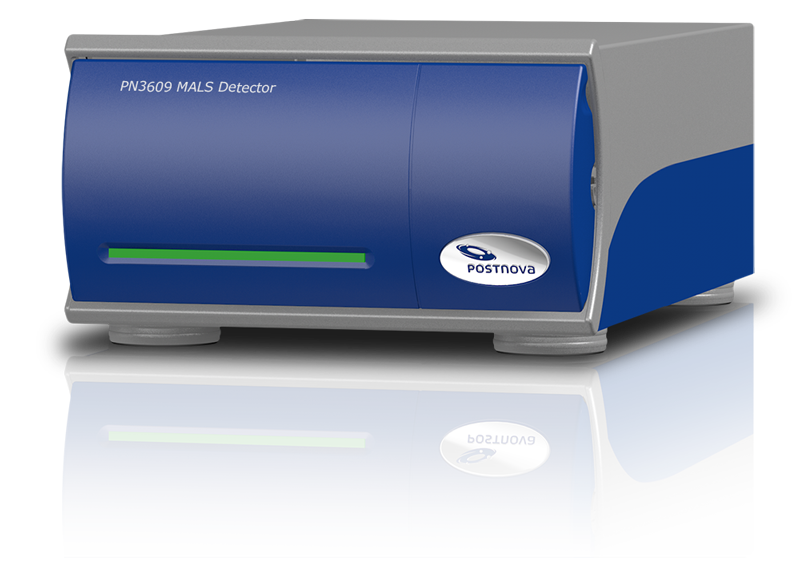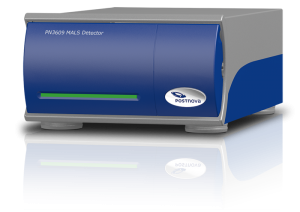PN3609 Multi-Angle Light Scattering Detector
Since the 1990s Postnova has been a leading innovator and developer of special advanced online Light Scattering solutions for coupling with chromatographic separation systems. The first model was the PD2000 - Static Light Scattering detector for coupling with Asymmetric Flow FFF. Later on the models PN3020 SLS and PN3070 MALS have been launched. Based on over two decades of practical experience, Postnova has collected a unique competence in the area of Laser Light Scattering and has developed the unique PN3609 MALS - Multi-Angle Light Scattering detector series. The model PN3609 MALS is a completely new type of high performance MALS detector system with a unique range of specifications.
Economic Angular Range
The Postnova PN3609 MALS detector system employs a well selected range of 9 scattering angles and therefore offers a very good economic performance ratio. It does not have the same full range of angles as the high-end model PN3621 MALS but still has all angles needed to become a reliable, rugged and precise light scattering instrument for all main applications of today’s bio-, nano- and polymer laboratories. All angles in the PN3609 are carefully selected in such a way that the majority of the applications is easily possible and that the resulting molar mass and size determination yields precise and stable results. Because of its more restricted number of angles the PN3609 MALS system may not be eligible for all high-end nanotech and polymer applications, especially for molar masses above 10E7 Da and sizes above 250 nm. However, because it employs 9 full angles the PN3609 has a superior performance compared to any other mid range MALS detector system, thus allowing high quality data and angular fits providing fully scientific and meaningful results for smaller to mid size samples.
For a precise and robust determination of molar mass and particles size, it is important to cover a broad range of angles which also includes sufficiently low angles. Historically, many approaches to employ mid range MALS detector systems have been strongly limited by the lack of low angles. In order to ensure a superior performance the PN3609 employs angles starting from as low as 28°. Although the most demanding nanoparticle and polymer applications would need even smaller angles than this, still the PN3609 has all „on board“ which makes it a reliable and robust day-to-day work tool in modern laboratories investigating small to mid-sized sample systems on a routine basis.
Clean Vertical Flow Cell
MALS is typically being used to measure larger sample species, such as protein aggregates, high molar mass macromolecules and particles. Because of their size and fragile nature these samples have to be treated in a gentle way to avoid any alteration. Potentially shear forces, chain degradation, conformational changes and deterioration or complete loss of bioactivity can be induced by too complex light scattering cells. Also aggregation, adsorption and sedimentation phenomena can cause trouble inside light scattering cells especially when they have edges, dead volumes or right angle flow path changes inside. The new Postnova PN3609 avoids all these limitations and offers a vertical flow cell where the sample can pass though easily without any obstacles in its way. The flow cell has no right angle entry and outlets which could induce shear forces or cause particles to settle and adsorb.
Advanced Electro Optics
The PN3609 MALS employs the latest opto-electronic designs, including digital signal processing for each of the 9 angles. The electronics is based on a true 24 bit resolution AD system and offers a broad dynamic signal range. For maximum flexibility it is possible to read-in up to 3 external analogue signals. The PN3609 has the smallest footprint available in the market, saving rare lab space and allowing a flexible use at different locations and also seamlessly fits into the line of other Postnova products, such as the PN3150 Refractive Index detector.
Economic Application Range
Because of its unique design and advanced performance features the instrument is ideally suited for the most challenging applications from various areas in science and technology:
- Biotechnology: Alginates, Carrageenans and Cell Proteins
- Biopharmaceutical: Peptides, Proteins, Antibodies and Aggregates
- Food and Agro Science: Pectins, Polysaccharides and Wheat Proteins
- Polymer Science: Polystyrene, Polycarbonate and Polyelectrolytes
- Environmental Research: Humic-Fulvic Acids and Exopolysaccharides

Sample Cell Volume:
63 µL
Pressure Stability:
5 bar
Light Scattering Volume:
< 7.8 nL
Wetted Parts:
Glass, Stainless Steel, PTFE +25 % carbon
Solvent Compatibility:
Aqueous and organic solvents with the same flow cell
Light Scattering Angles:
28° – 156° at 9 angles
0-10 Volt at 24 Bit
0.6 nV Resolution
Signal Processing:
DSP on every single Photo Detector, Different Filter Algorithms possible
Molar Mass Range:
Approx. 103 to 109 Daltons depending on sample
Radius of Gyration Range:
Approx. 8 nm to 500 nm depending on sample
Laser Specifications:
532 nm (green)
2.5 – 50 mW adjustable other wavelength and filter options available on request
Laser Life Time:
Approx. 10.000 hours
Safety Functions:
Vapor Sensor
Leak Sensor
Cell Temperature Control:
10°C above Room Temperature up to 50°C
Stability ± 0.01°C at 35°C
Dimensions:
46 cm x 26 cm x 16 cm
Shipping Weight :
13 kg
Power Requirements:
100 - 240 V, 50/60 Hz, 155 W, Universal Power Input
Computer Requirements:
Needs a PC/System with a free Ethernet connection or a Ethernet Hub for operation!
Electronic Inputs/Outputs:
Error In/Out, Injection Ready
In/Out, Ethernet Interface
Environmental Conditions:
20 – 80 % relative humidity (noncondensing) at an ambient temperature range of 4 – 30°C (when the laser is activated above 10°C)




